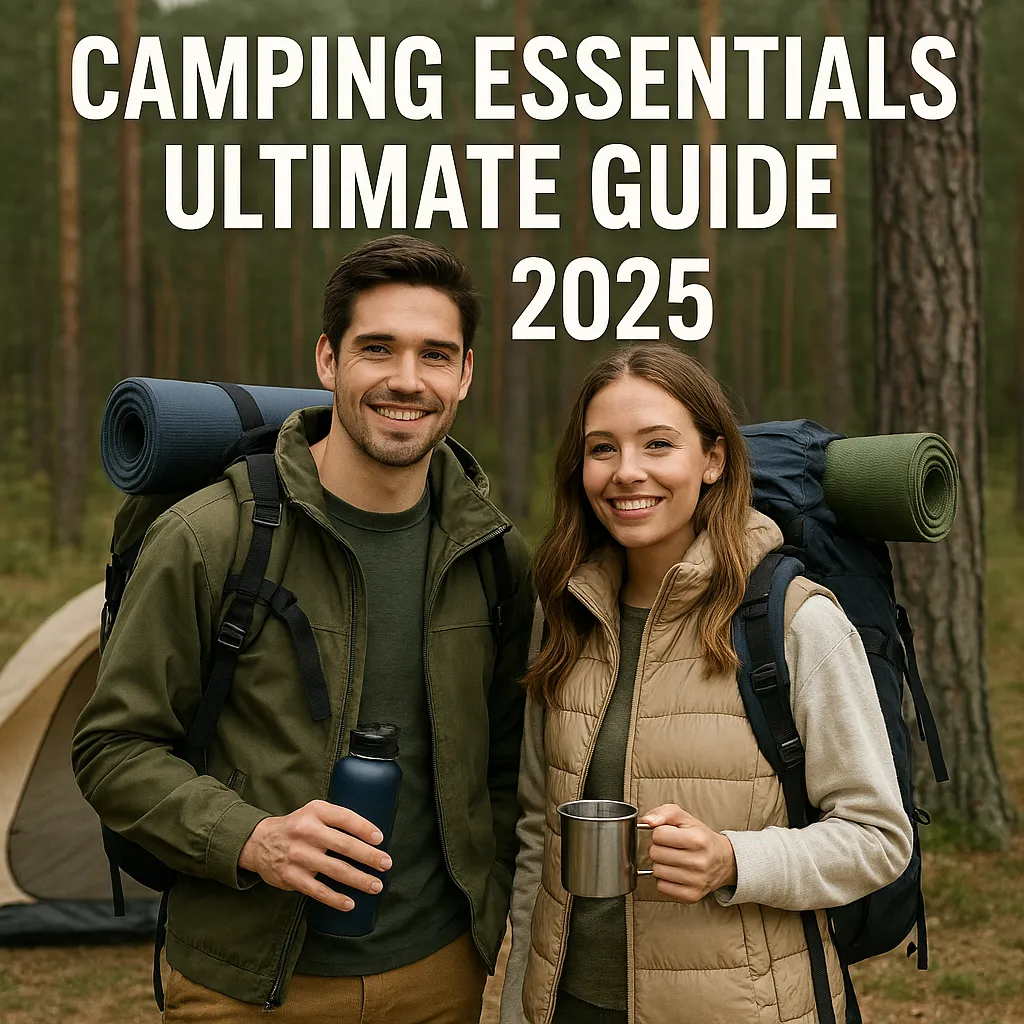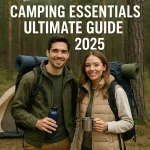- Baby Toys 2026: The Ultimate Expert Guide - 12/04/2025
- Father’s Day 2025 Gifts: The Ultimate Guide - 11/11/2025
- Dating Apps Ultimate 2025 Guide - 10/23/2025
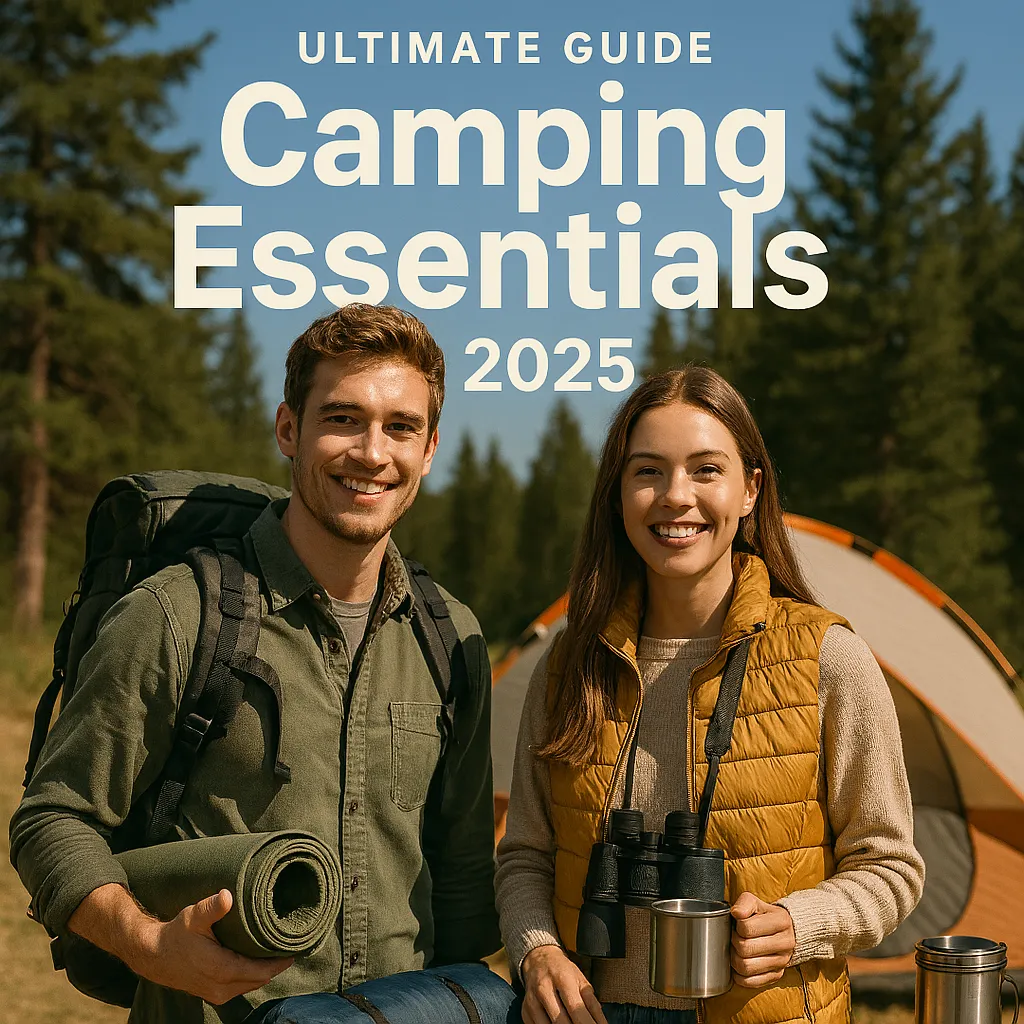
Table of Contents
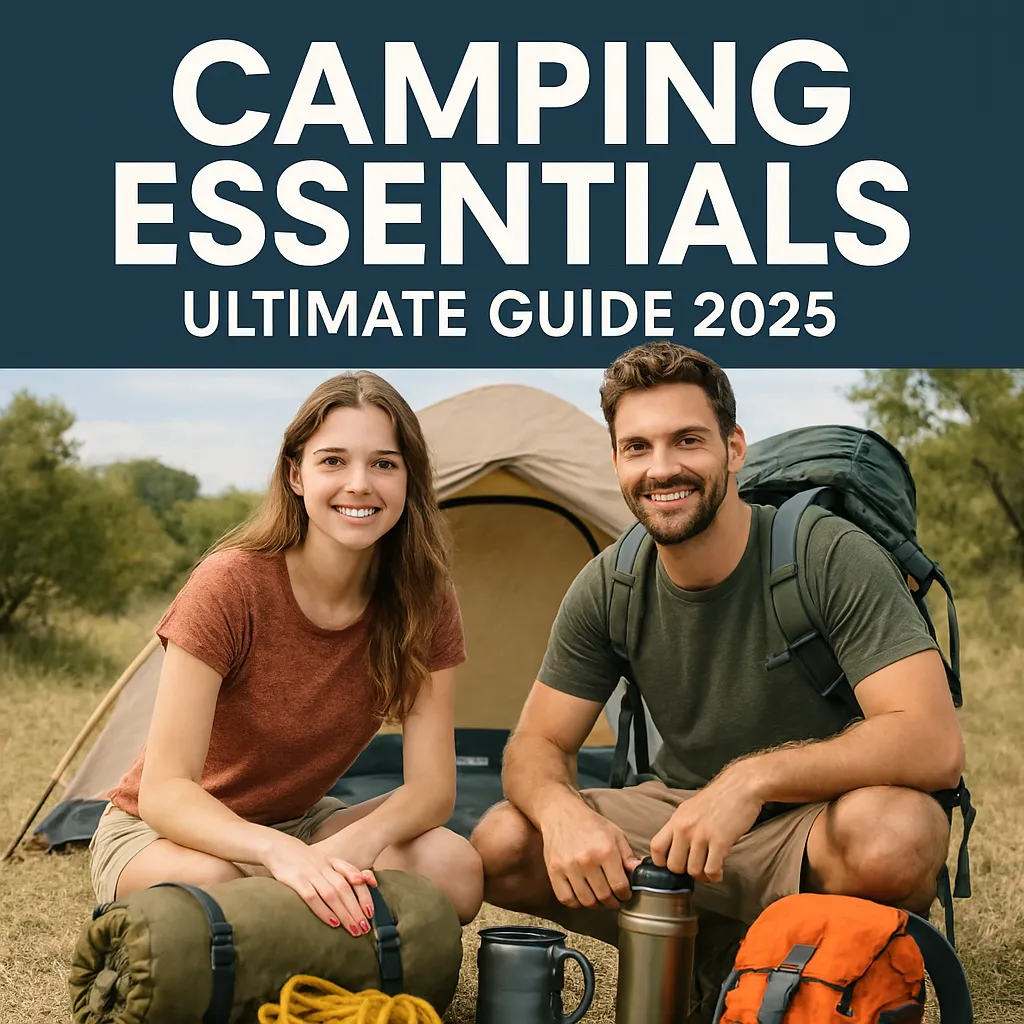
🏕️ Part 1: Camping Essentials: The Ultimate Guide 2025
🌟 Introduction: Why Camping Essentials Matter
Camping is more than just sleeping under the stars — it’s about reconnecting with nature, escaping daily routines, and finding peace outdoors. But without the right essentials, a trip meant for relaxation can quickly become stressful.
Imagine arriving at camp and realizing you forgot a lighter, or waking up cold at 3 a.m. because your sleeping bag wasn’t warm enough. That’s where camping essentials come in — the gear and supplies that keep you safe, comfortable, and prepared.
A solid checklist ensures:
- ✅ Safety (first aid, navigation tools, shelter)
- ✅ Comfort (proper clothing, warm sleeping system)
- ✅ Convenience (organized cooking gear, efficient packing)
- ✅ Sustainability (eco-friendly choices, minimal impact)
This guide will walk you through core gear, food, clothing, navigation, sustainability, and expert hacks — backed with data, expert references, and easy-to-use tables.
🧰 The Core Gear Checklist
At the heart of every camping trip is a set of core essentials. No matter if you’re car camping for a weekend or backpacking across rugged trails, these items form the foundation of your experience.
✅ Core Camping Gear Must-Haves
- Tent 🏕️ – Your shelter, protection from weather & bugs.
- Sleeping Bag 🛌 – Keeps you warm; choose based on season.
- Sleeping Pad 💤 – Insulation + comfort from hard/cold ground.
- Backpack 🎒 – Carries your gear; size depends on trip length.
- Cooking Stove 🔥 – For boiling water, cooking meals.
- Cookware 🍳 – Lightweight pots, pans, utensils.
- Lighting 🔦 – Headlamp or lantern for nighttime use.
- First Aid Kit 🚑 – For emergencies and minor injuries.
- Navigation 🧭 – Map, compass, GPS (never rely on phone alone).
- Water System 💧 – Refillable bottles + water filter or purifier.
📊 Comparison Table: Core Camping Gear Essentials
| Gear Item | Recommended Weight (Backpacking) | Average Cost Range | Durability Rating (1-5) | Notes |
|---|---|---|---|---|
| Tent 🏕️ | 1.5 – 3.5 kg | $100 – $400 | ⭐⭐⭐⭐ | Choose 3-season or 4-season depending on climate |
| Sleeping Bag 🛌 | 1 – 2 kg | $80 – $350 | ⭐⭐⭐⭐ | Down = lighter, warmer; Synthetic = cheaper, better in wet |
| Sleeping Pad 💤 | 300 – 700 g | $30 – $180 | ⭐⭐⭐ | Foam = cheap but bulky; Inflatable = comfy but delicate |
| Backpack 🎒 | 1.5 – 3 kg | $120 – $450 | ⭐⭐⭐⭐ | 40–70L capacity; internal frame better for long trips |
| Stove 🔥 | 80 – 500 g | $40 – $200 | ⭐⭐⭐⭐ | Canister stoves = easy; Liquid fuel = good for winter |
| Cookware 🍳 | 200 – 800 g | $20 – $150 | ⭐⭐⭐ | Titanium = light & pricey; Aluminum = budget option |
| Lighting 🔦 | 100 – 400 g | $20 – $100 | ⭐⭐⭐⭐ | Headlamps = hands-free; Solar lanterns = eco option |
| First Aid 🚑 | 200 – 500 g | $15 – $60 | ⭐⭐⭐⭐ | Customize for trip type & group size |
| Navigation 🧭 | 100 – 300 g | $15 – $300 | ⭐⭐⭐⭐ | Always carry map + compass; GPS = backup |
| Water System 💧 | 300 – 700 g | $25 – $120 | ⭐⭐⭐⭐ | Filters remove bacteria; Purifiers remove viruses too |
📋 Form: Core Gear Checklist (Printable)
You can use this as a check-off form before heading out:
Camping Essentials Checklist Form 🏕️
- Tent
- Sleeping Bag
- Sleeping Pad
- Backpack
- Cooking Stove
- Cookware (Pot, Pan, Spork)
- Lighting (Headlamp/Lantern)
- First Aid Kit
- Navigation (Map + Compass/GPS)
- Water Bottles + Filter/Purifier
📚 Authoritative References (Part 1)
- Leave No Trace Center for Outdoor Ethics – Sustainability guidelines.
- REI Co-op Camping Checklist – Gear recommendations.
- National Park Service – Camping Basics – Safety and preparation tips.
- Backpacker Magazine – Gear Guides (backpacker.com/gear).
👕 Part 2: Clothing Essentials for Camping
🌦️ Why Clothing Matters Outdoors
Clothing isn’t just about comfort when camping — it’s a matter of safety, performance, and adaptability. The wrong clothes can leave you soaked, cold, or overheated, while the right system keeps you dry, warm, and ready for changing conditions.
Unlike daily wear, camping clothes must:
- ✅ Regulate body temperature across different weather conditions
- ✅ Protect from wind, rain, and sun
- ✅ Be lightweight and packable
- ✅ Dry quickly & wick sweat away
- ✅ Be durable for rugged use
🧥 The Layering System Explained
One of the most reliable clothing strategies for camping (and hiking) is the three-layer system:
- Base Layer 👕 (Moisture Management)
- Wicks sweat away from the body
- Materials: Merino wool, synthetic polyester
- Avoid: Cotton (absorbs water, dries slowly)
- Mid Layer 🧣 (Insulation)
- Retains body heat in cooler weather
- Materials: Fleece, down, synthetic insulation
- Choose based on season (light fleece for summer nights, down jacket for winter)
- Outer Layer 🧥 (Weather Protection)
- Shields from wind, rain, and snow
- Materials: Gore-Tex, waterproof breathable shells
- Must balance durability, waterproof rating, and breathability
👉 This system allows you to add or remove layers depending on activity and weather, making it versatile for year-round camping.
📊 Comparison Table: Camping Clothing Essentials
| Layer | Key Purpose | Best Materials | Avg. Weight | Cost Range | Notes |
|---|---|---|---|---|---|
| Base Layer 👕 | Sweat-wicking & comfort | Merino wool, polyester blends | 150–300 g | $30 – $100 | Avoid cotton; merino = odor-resistant |
| Mid Layer 🧣 | Insulation | Fleece, down, synthetic fill | 250–600 g | $50 – $250 | Down = best warmth-to-weight; synthetic = better when wet |
| Outer Layer 🧥 | Wind & rain protection | Gore-Tex, nylon, polyester shell | 300–800 g | $80 – $350 | Look for waterproof rating ≥ 10,000 mm |
| Pants 👖 | Mobility & protection | Nylon, softshell, fleece (winter) | 300–700 g | $40 – $200 | Convertible pants = versatile |
| Footwear 👟🥾 | Stability & comfort | Leather boots, trail shoes | 900–1,600 g | $60 – $300 | Choose by terrain & pack weight |
| Accessories 🧢🧤 | Extra warmth & safety | Wool hats, gloves, buffs | 100–300 g | $15 – $80 | Critical in cold climates |
🥾 Footwear: The Foundation of Comfort
If there’s one piece of clothing you cannot skimp on, it’s footwear. Blisters or wet feet can ruin a trip.
- Light Hiking Shoes 👟 – For short trips, easy terrain.
- Mid/High Hiking Boots 🥾 – For multi-day trips, heavy packs, rugged terrain.
- Camp Shoes / Sandals 🩴 – Lightweight for relaxing at camp.
- Wool Socks 🧦 – Cushion + moisture control (carry spares).
👉 Pro Tip: Break in new boots before your trip.
🧼 Clothing Care & Packing Tips
- Roll clothes to save space (instead of folding).
- Pack clothes in dry bags or compression sacks to keep them waterproof.
- Always carry a dedicated dry set for sleeping.
- Choose neutral/dark colors for hiding dirt and extending wear.
📋 Form: Camping Clothing Checklist
Use this printable-style checklist before every trip:
Clothing Essentials Form 👕
- Base Layer (Top + Bottom)
- Mid Layer (Fleece/Down Jacket)
- Outer Layer (Rain Shell/Windbreaker)
- Hiking Pants (or Convertible Pants)
- Extra T-shirt (Quick-dry)
- Hiking Socks (x2–3 pairs)
- Camp Shoes/Sandals
- Hat/Cap (Sun or Wool)
- Gloves (Weather-appropriate)
- Sleepwear (Dry & Comfy)
📚 Authoritative References (Part 2)
- American Hiking Society – Clothing for the Trail
- REI Co-op Expert Advice – Layering Basics
- Backpacker Magazine – Gear & Clothing Guides
- National Outdoor Leadership School (NOLS) – Clothing Systems for Wilderness Travel
🍳 Part 3: Cooking & Food Gear for Camping
🌟 Why Cooking Gear Matters
Food is fuel — especially in the outdoors. Having the right cooking system means you can:
- ✅ Boil water quickly for coffee or tea ☕
- ✅ Prepare hot meals that keep morale high 🍲
- ✅ Ensure food safety by cooking thoroughly 🥘
- ✅ Reduce waste with reusable cookware & storage ♻️
Without proper gear, you might end up eating only cold snacks or struggling to cook in poor weather.
🔥 Types of Camping Stoves
Choosing the right stove depends on trip type, duration, fuel availability, and conditions:
- Canister Stoves 🥤
- Lightweight, fast, easy to use
- Best for backpacking & short trips
- Limitation: less effective in extreme cold
- Liquid Fuel Stoves ⛽
- Reliable in cold and high-altitude conditions
- Fuel (white gas, kerosene) widely available
- Heavier and require priming
- Wood-Burning Stoves 🌲🔥
- Fuel is free (sticks, twigs)
- Eco-friendly & lightweight
- Not reliable in wet environments
- Solid Fuel Stoves 🧊
- Ultralight emergency option
- Small tablets, easy to store
- Limited cooking capacity
🍲 Essential Cookware & Utensils
Cooking outdoors is simpler than at home, but you still need reliable tools:
- Pot & Pan (Titanium, Aluminum, or Stainless Steel)
- Spork/Utensil Kit 🍴 (multi-use saves weight)
- Mug/Cup ☕ (insulated recommended)
- Cutting Tool 🔪 (small folding knife)
- Lid/Strainer Combo (faster cooking, saves fuel)
👉 Pro Tip: Titanium = ultralight but pricey; Aluminum = budget-friendly; Stainless = durable but heavier.
🥡 Food Storage & Safety
- Bear Canister / Bear Bag 🐻 (required in many U.S. parks)
- Dry Bags / Stuff Sacks 🧳 (waterproof protection)
- Cooler 🧊 (for car camping only)
- Resealable Bags ♻️ (portion meals, reduce waste)
📊 Comparison Table: Camping Stoves & Cookware
| Gear Type | Avg. Weight | Cost Range | Best For | Pros | Cons |
|---|---|---|---|---|---|
| Canister Stove 🥤 | 70–300 g | $30–$150 | Weekend & backpacking | Fast, clean, easy | Less effective in cold, fuel can be expensive |
| Liquid Fuel Stove ⛽ | 300–600 g | $80–$200 | Long trips, winter | Works in extreme cold, refillable | Heavier, needs maintenance |
| Wood Stove 🌲🔥 | 150–400 g | $20–$120 | Ultralight, eco-friendly trips | No fuel to carry | Not reliable in wet/rain |
| Solid Fuel Stove 🧊 | 50–150 g | $10–$50 | Emergency use | Tiny, ultralight | Slow, limited cooking |
| Titanium Cookware | 150–400 g | $50–$150 | Ultralight backpacking | Light, durable | Expensive, hotspots when cooking |
| Aluminum Cookware | 250–600 g | $20–$80 | Budget trips | Affordable, good heat conduction | Less durable |
| Stainless Cookware | 400–900 g | $30–$120 | Car camping, durability | Strong, scratch-resistant | Heavy |
🥪 Food Ideas for Camping
- Breakfast 🍳 – Instant oats, granola, powdered eggs
- Lunch 🥪 – Tortillas with nut butter, jerky, cheese
- Dinner 🍲 – Dehydrated meals, pasta, rice + veggies
- Snacks 🍫 – Trail mix, dried fruit, protein bars
👉 Always plan high-calorie, lightweight foods for backpacking.
📋 Form: Cooking & Food Gear Checklist
Cooking Essentials Form 🍳🔥
- Stove (Canister / Liquid Fuel / Wood / Solid)
- Fuel Canister or Bottle (with Backup)
- Pot & Pan (Lightweight)
- Utensils (Spork, Knife, Cup)
- Lighter + Waterproof Matches
- Food Storage (Bear Canister, Dry Bags)
- Cooler (Car Camping)
- Dish Soap + Scrubber (Eco-Friendly)
- Resealable Bags / Containers
- Trash Bag (Pack it out ♻️)
📚 Authoritative References (Part 3)
- National Park Service – Food Storage & Bears
- Leave No Trace – Waste & Cooking Guidelines
- REI Co-op – How to Choose a Camping Stove
- Backpacker Magazine – Outdoor Cooking & Recipes
🧭 Part 4: Navigation & Safety Essentials for Camping
🌟 Why Navigation & Safety Matter
Nature is beautiful, but it can also be unpredictable. Even short camping trips can turn dangerous if you:
- Lose the trail 🚶
- Face sudden weather changes 🌧️
- Experience an injury or illness 🤕
- Run out of daylight 🌙
With the right navigation tools and safety gear, you can prevent emergencies — and if something happens, you’ll be ready.
🗺️ Navigation Tools Every Camper Needs
- Map (Topographic) 🗺️
- The most reliable navigation tool.
- Waterproof versions recommended.
- Compass 🧭
- Lightweight and battery-free.
- Learn basic orienteering before your trip.
- GPS Device 📡
- Accurate and easy to use.
- Requires batteries or solar charger.
- Smartphone Apps 📱
- Useful for offline maps (e.g., Gaia GPS, AllTrails).
- Risk: battery drain or poor signal.
👉 Pro Tip: Always carry map + compass as a backup, even if you bring a GPS or phone.
🚑 Safety & First Aid Essentials
- First Aid Kit (customized for group size & trip length)
- Emergency Shelter ⛺ (lightweight tarp, bivvy sack)
- Fire Starters 🔥 (lighter, waterproof matches, ferro rod)
- Whistle 📢 (for signaling rescue)
- Headlamp 🔦 (extra batteries included)
- Water Purification 💧 (filters, iodine tablets)
- Personal Locator Beacon (PLB) 📡 or Satellite Messenger (for emergencies beyond cell coverage)
📊 Comparison Table: Navigation & Safety Gear
| Item | Avg. Weight | Cost Range | Reliability | Best Use |
|---|---|---|---|---|
| Map 🗺️ | 50–150 g | $10–$20 | ⭐⭐⭐⭐⭐ | Always reliable, requires knowledge |
| Compass 🧭 | 30–80 g | $15–$60 | ⭐⭐⭐⭐⭐ | Lightweight, durable, essential backup |
| GPS Device 📡 | 150–300 g | $120–$600 | ⭐⭐⭐⭐ | Easy navigation, needs power |
| Smartphone App 📱 | 200 g+ | Free – $40 | ⭐⭐⭐ | Convenient, but battery-dependent |
| First Aid Kit 🚑 | 200–600 g | $15–$70 | ⭐⭐⭐⭐ | Customizable for needs |
| Emergency Shelter ⛺ | 200–500 g | $20–$80 | ⭐⭐⭐⭐ | Backup protection from weather |
| Fire Starter 🔥 | 20–100 g | $5–$30 | ⭐⭐⭐⭐ | Carry at least 2 methods |
| PLB / Satellite Messenger 📡 | 150–300 g | $200–$500 | ⭐⭐⭐⭐⭐ | Critical for remote areas |
🆘 Emergency Preparedness Checklist
Always plan for unexpected scenarios:
- Tell someone your trip plan before leaving 📋
- Pack extra food (at least one day’s worth) 🍫
- Bring extra layers for sudden weather drops ❄️
- Know basic first aid (CPR, wound care) 🩹
- Learn local emergency numbers 🚓🚁
📋 Form: Navigation & Safety Checklist
Navigation & Safety Form 🧭🚑
- Topographic Map (Waterproof if possible)
- Compass (Test before trip)
- GPS Device (Charged + Backup Batteries)
- Smartphone with Offline Maps
- First Aid Kit (Customized)
- Emergency Shelter (Bivy/Tarp)
- Fire Starter (Lighter + Waterproof Matches)
- Whistle (Signal Device)
- Headlamp (Extra Batteries)
- Water Filter or Purification Tablets
- PLB / Satellite Messenger (Remote trips)
📚 Authoritative References (Part 4)
- American Red Cross – Wilderness & Remote First Aid
- National Park Service – Navigation & Safety Basics
- Wilderness Medical Society – First Aid Guidelines
- REI Co-op – Navigation Basics
🚿 Part 5: Hygiene & Comfort Essentials for Camping
🌟 Why Hygiene & Comfort Matter
Camping should be refreshing, not stressful. But without basic hygiene and comfort items, trips can quickly turn unpleasant. Poor hygiene can lead to:
- Illness (GI issues, infections) 🤒
- Attracting wildlife 🐻
- Low morale 😓
Meanwhile, comfort items improve rest, relaxation, and overall trip satisfaction. The right balance ensures both practicality and enjoyment.
🧴 Hygiene Essentials for Campers
- Biodegradable Soap 🧼
- Use for hands, dishes, and even laundry.
- Must be at least 200 ft (60 m) from water sources (Leave No Trace rule).
- Toothbrush & Toothpaste 🦷
- Travel-sized options save weight.
- Consider eco-toothpaste tabs to cut plastic waste.
- Toilet Paper & Trowel 🧻⛏️
- For areas without toilets, dig a 6–8 inch “cathole.”
- Pack out TP in a sealed bag where required.
- Hand Sanitizer 🧴
- Quick hygiene fix when water is limited.
- Quick-Dry Towel 🏖️
- Compact microfiber towels = fast drying, lightweight.
- Menstrual Products 🌸
- Reusable menstrual cups or period underwear = eco-friendly.
- Insect Repellent 🦟
- DEET, picaridin, or natural lemon-eucalyptus oil.
😌 Comfort Essentials
- Camping Chair 🪑
- Lightweight folding chair for relaxing by the fire.
- Sleeping Pillow 😴
- Inflatable or compressible travel pillow.
- Hammock 🌲
- Great for lounging; doubles as emergency shelter.
- Earplugs & Eye Mask 😴
- Helpful if camping in noisy sites or under bright moonlight.
- Portable Shower 🚿
- Gravity-fed or solar-powered bags for multi-day trips.
📊 Comparison Table: Hygiene & Comfort Essentials
| Item | Avg. Weight | Cost Range | Eco-Friendly? | Best For |
|---|---|---|---|---|
| Biodegradable Soap 🧼 | 100–200 g | $5–$15 | ✅ | All camping trips |
| Toothpaste Tabs 🦷 | 50–100 g | $5–$12 | ✅ | Backpacking, minimal waste |
| Toilet Paper + Trowel 🧻 | 200–300 g | $5–$20 | ✅ (if packed out) | Areas without toilets |
| Quick-Dry Towel 🏖️ | 200–400 g | $10–$30 | ✅ | Multi-day trips |
| Menstrual Cup 🌸 | 30 g | $25–$40 | ✅ | Long trips, eco-conscious camping |
| Insect Repellent 🦟 | 100–200 g | $5–$15 | ⚠️ (depends on formula) | Summer, humid climates |
| Camping Chair 🪑 | 900–1,500 g | $25–$120 | ⚠️ | Car camping, comfort |
| Hammock 🌲 | 500–1,000 g | $40–$150 | ✅ | Relaxation, ultralight shelter |
| Inflatable Pillow 😴 | 100–200 g | $15–$50 | ⚠️ | Backpacking & car camping |
| Portable Shower 🚿 | 400–1,200 g | $20–$60 | ⚠️ | Long stays, car camping |
🧼 Eco-Friendly Hygiene Tips (Leave No Trace)
- Use small amounts of soap far from water sources.
- Pack out all trash, TP, and hygiene products.
- Consider reusable containers for toiletries.
- For multi-day trips: use wet wipes sparingly (and pack them out).
- Dispose of greywater responsibly — scatter it, don’t dump it.
📋 Form: Hygiene & Comfort Checklist
Hygiene & Comfort Essentials Form 🚿🧻
- Biodegradable Soap
- Toothbrush + Toothpaste Tabs
- Toilet Paper + Trowel
- Hand Sanitizer
- Quick-Dry Towel
- Menstrual Products (if needed)
- Insect Repellent
- Camping Chair
- Hammock
- Sleeping Pillow
- Earplugs & Eye Mask
- Portable Shower
📚 Authoritative References (Part 5)
- Leave No Trace – Sanitation & Hygiene in the Outdoors
- Centers for Disease Control and Prevention (CDC) – Outdoor Hygiene
- REI Co-op – Hygiene in the Backcountry
- National Park Service – Camping Comfort Tips
🌱 Part 6: Sustainable Camping Essentials
🌟 Why Sustainability Matters Outdoors
Camping connects us with nature — but it also comes with responsibility. The outdoor community follows the principle of “Leave No Trace” (LNT), which emphasizes minimizing human impact. Sustainable camping helps:
- ✅ Preserve ecosystems 🌳
- ✅ Protect wildlife 🐿️
- ✅ Reduce pollution ♻️
- ✅ Ensure trails and campsites remain for future generations 🌍
By making eco-conscious gear and behavior choices, campers can enjoy nature without damaging it.
🌍 The 7 Leave No Trace Principles
- Plan Ahead & Prepare 🗺️ – Prevent waste by packing smart.
- Travel & Camp on Durable Surfaces 🥾 – Stick to trails/campsites.
- Dispose of Waste Properly 🚮 – Pack it in, pack it out.
- Leave What You Find 🌸 – Don’t disturb plants or artifacts.
- Minimize Campfire Impact 🔥 – Use stoves; small fires only where allowed.
- Respect Wildlife 🐻 – Observe from distance, never feed animals.
- Be Considerate of Others 🤝 – Keep noise down, share trails respectfully.
🌞 Eco-Friendly Gear Choices
- Reusable Water Bottles & Hydration Systems 💧
- Avoid single-use plastics.
- Solar Chargers & Power Banks 🔋
- Renewable power for devices, lanterns, and GPS.
- LED Lighting 💡
- Longer-lasting and energy-efficient compared to fuel lanterns.
- Eco-Friendly Toiletries 🧼
- Biodegradable soap, toothpaste tabs, and reusable cloths.
- Recyclable or Compostable Food Packaging 🥡
- Choose bulk packing or compostable wrappers.
- Sustainable Clothing 👕
- Organic cotton, recycled polyester, merino wool.
📊 Comparison Table: Sustainable Camping Gear
| Gear Type | Eco-Friendly Alternative | Benefits | Cost Range | Notes |
|---|---|---|---|---|
| Water Containers 💧 | Reusable bottle (Nalgene, Hydro Flask) | Cuts single-use plastic | $15–$50 | Durable, long-lasting |
| Power Supply 🔋 | Solar charger / power bank | Renewable energy | $30–$150 | Works best in sunny conditions |
| Lighting 💡 | LED lantern/headlamp | Energy-efficient, long battery life | $20–$100 | Rechargeable preferred |
| Toiletries 🧼 | Biodegradable soap, tabs | Reduces water pollution | $5–$15 | Must use far from streams/lakes |
| Cookware 🍳 | Titanium/Aluminum sets | Durable, reusable | $20–$150 | Lighter than disposable options |
| Food Storage 🥡 | Bear canister, dry bags | Wildlife-safe, reusable | $30–$100 | Required in some areas |
| Clothing 👕 | Recycled fabrics, merino wool | Lower environmental impact | $30–$200 | Long-lasting, odor resistant |
🔋 Renewable Energy for Camping
- Solar Panels ☀️ – Foldable panels can charge phones, GPS, lanterns.
- Hand-Crank Generators 🔄 – Reliable backup when sunlight is limited.
- Rechargeable Batteries 🔋 – Replace disposable batteries.
- Solar-Powered Lanterns 💡 – Charge during the day, use at night.
🗑️ Waste Management Tips
- Carry trash bags (pack out all garbage).
- Minimize packaging by pre-portioning food.
- Reuse zip bags, containers, and fuel bottles.
- Compost where facilities exist.
- Avoid single-use plastics (cutlery, plates, straws).
📋 Form: Sustainable Camping Checklist
Sustainable Camping Form 🌱♻️
- Reusable Water Bottle / Hydration Bladder
- Solar Charger / Power Bank
- LED Headlamp / Lantern (Rechargeable)
- Biodegradable Soap & Toiletries
- Reusable Cookware & Utensils
- Compostable or Bulk Food Packaging
- Bear Canister or Dry Bag
- Recycled/Organic Clothing Layers
- Trash Bags (Pack it Out)
- Small Recycling Bag
📚 Authoritative References (Part 6)
- Leave No Trace Center for Outdoor Ethics
- National Park Service – Sustainable Camping Practices
- REI Co-op – Eco-Friendly Camping Gear Guide
- The Nature Conservancy – Reducing Outdoor Impact
😌 Part 7: Luxury & Nice-to-Have Camping Gear
🌟 Why Luxury Items Matter
While core gear keeps you alive and safe, luxury items make camping comfortable, relaxing, and memorable. Especially for car camping or family trips, adding small luxuries can:
- ✅ Improve relaxation 🛋️
- ✅ Enhance social time 🎶🔥
- ✅ Boost sleep quality 😴
- ✅ Make trips kid- and family-friendly 👨👩👧
These aren’t survival essentials, but they can transform a good trip into an amazing one.
🪑 Comfort at Camp: Furniture & Relaxation
- Camping Chair 🪑
- Lightweight folding chair with cup holder = evening relaxation.
- Ultralight versions exist for backpackers.
- Camping Table 🍽️
- Useful for cooking, card games, or family meals.
- Compact roll-up versions save space.
- Hammock 🌲
- Perfect for lounging mid-day or stargazing at night.
- Some hammocks double as ultralight shelters.
🎶 Entertainment & Atmosphere
- Portable Speaker 🎵
- Small Bluetooth speaker for music.
- Keep volume low to respect others and wildlife.
- Books or Kindle 📚
- Great for downtime or quiet evenings.
- Cards & Games 🃏🎲
- Compact deck of cards = endless fun.
- Camera / Binoculars 📷🔭
- Capture wildlife, landscapes, or starry skies.
❄️ Food & Drink Luxuries
- Cooler / Ice Chest 🧊
- Keeps drinks cold and fresh foods safe.
- Essential for car camping, not for backpacking.
- Portable Coffee Maker ☕
- French press, AeroPress, or pour-over setup.
- Camp Grill / Dutch Oven 🍖🍲
- Allows more versatile cooking than a stove.
- Reusable Wine Tumblers / Beer Growler 🍷🍺
- For adults who want a little luxury beverage at camp.
🔋 Tech & Power Luxuries
- Solar Lanterns & String Lights 💡✨
- Add ambiance and visibility to campsites.
- Portable Power Station 🔋
- Recharge multiple devices at once.
- Electric Cooler/Fridge ❄️
- Runs off vehicle or solar setup.
- Portable Fan or Heater 🌬️🔥
- Helps with extreme temperatures.
📊 Comparison Table: Luxury Camping Gear
| Item | Avg. Weight | Cost Range | Best For | Notes |
|---|---|---|---|---|
| Camping Chair 🪑 | 1–3 kg | $25–$150 | Car camping, comfort | Ultralight options for backpacking exist |
| Camping Table 🍽️ | 2–5 kg | $40–$180 | Family meals, group cooking | Roll-up designs save space |
| Hammock 🌲 | 500–1,200 g | $40–$150 | Relaxation, stargazing | Can double as ultralight shelter |
| Cooler 🧊 | 3–15 kg | $40–$400 | Car camping, cold storage | Not practical for backpacking |
| Portable Coffee Maker ☕ | 200–600 g | $20–$100 | Coffee lovers | Compact models work with camping stoves |
| Camp Grill / Dutch Oven 🍲 | 2–8 kg | $40–$200 | Gourmet camp cooking | Heavy, best for vehicle camping |
| Portable Speaker 🎶 | 200–600 g | $30–$150 | Relaxation, music | Keep volume respectful |
| Solar String Lights ✨ | 300–700 g | $20–$60 | Ambience, family fun | Recharge during the day |
| Portable Power Station 🔋 | 5–15 kg | $200–$1,000 | Long trips, off-grid power | Powers multiple devices |
| Electric Cooler ❄️ | 10–20 kg | $250–$800 | Extended vehicle trips | Needs vehicle or solar input |
🧠 Tips for Choosing Luxury Gear
- Prioritize weight vs comfort: Ultralight = less comfort, more mobility.
- Match luxuries to trip type: Backpacking = minimal extras; Car camping = more freedom.
- Pick multi-use luxuries: Hammocks = relaxation + emergency shelter.
- Don’t overspend: Luxury ≠ essential, so choose based on enjoyment value.
📋 Form: Luxury & Nice-to-Have Camping Gear Checklist
Luxury Camping Form 😌🎶
- Camping Chair
- Camping Table
- Hammock
- Cooler / Ice Chest
- Portable Coffee Maker
- Camp Grill / Dutch Oven
- Wine/Beer Cups
- Portable Speaker
- Books / Games
- Camera / Binoculars
- Solar Lanterns / String Lights
- Portable Power Station
- Electric Cooler
- Portable Fan / Heater
📚 Authoritative References (Part 7)
- REI Co-op – Best Camping Luxuries & Comfort Gear
- Outdoor Gear Lab – Car Camping Comfort Reviews
- Leave No Trace – Respecting Others Outdoors
- National Park Service – Camping with Families
❄️☀️🍂🌧️ Part 8: Seasonal Camping Essentials
🌟 Why Seasonal Prep Matters
Camping conditions shift dramatically with the seasons. The gear that works in July heat ☀️ may be dangerous in January snow ❄️. Seasonal essentials ensure:
- ✅ Comfort across climates
- ✅ Safety in extreme conditions
- ✅ Better trip planning
- ✅ Reduced risk of emergencies
☀️ Summer Camping Essentials
Challenges: Heat, dehydration, insects, UV exposure.
Key Gear:
- Lightweight tent with mesh panels 🏕️
- Breathable sleeping bag (40°F/5°C rating) 🛏️
- Hydration bladder or insulated bottle 💧
- Sun protection (hat, sunscreen, UPF clothing) 🧴
- Insect repellent & bug net 🦟
- Portable fan or battery-powered cooling device 🌬️
❄️ Winter Camping Essentials
Challenges: Hypothermia, frostbite, snow navigation.
Key Gear:
- 4-season tent ⛺ with snow skirts
- Sleeping bag (0°F/-18°C or lower) 🛏️
- Sleeping pad with high R-value (insulation) 🛡️
- Stove with liquid fuel (works in sub-zero temps) 🔥
- Avalanche safety gear (beacon, probe, shovel) 🏔️
- Extra layers: merino wool, down, synthetic jackets 🧥
- Snowshoes or crampons depending on terrain 🥾
🍂 Fall Camping Essentials
Challenges: Unpredictable weather, cold nights, early sunsets.
Key Gear:
- 3-season tent 🏕️
- Sleeping bag (20–30°F / -6–0°C) 🛏️
- Layering system (base, mid, shell) 👕
- Extra tarp for rain/wind protection ⛱️
- Lanterns/headlamps with extra batteries 🔦
- Insulated jacket & gloves 🧤
🌧️ Rainy Season Camping Essentials
Challenges: Flooding, damp gear, slippery trails.
Key Gear:
- Waterproof tent with strong rainfly ⛺
- Ground tarp/footprint 🌍
- Quick-dry clothing (nylon, polyester) 👕
- Waterproof boots & gaiters 🥾
- Dry bags & pack liners 🎒
- Portable clothesline for drying 👕🪢
- Extra socks & waterproof gloves 🧦
📊 Seasonal Camping Gear Comparison Table
| Season | Shelter | Sleeping System | Cooking Gear | Clothing | Extras |
|---|---|---|---|---|---|
| ☀️ Summer | Mesh-heavy tent | Light bag (40°F/5°C) | Canister stove | UPF clothing, hat | Bug net, fan |
| ❄️ Winter | 4-season tent | Heavy bag (0°F/-18°C) + insulated pad | Liquid fuel stove | Wool/down layers | Avalanche gear, snowshoes |
| 🍂 Fall | 3-season tent | Midweight bag (20°F/-6°C) | Standard stove | Layered system | Tarp, lantern |
| 🌧️ Rainy | Waterproof tent + tarp | Synthetic bag (warmer when damp) | Standard stove | Quick-dry clothes | Dry bags, waterproof boots |
🧠 Seasonal Tips from Experts
- Hydration: Even in cold weather, dehydration is a risk.
- Layering: Always bring one more layer than you think you’ll need.
- Moisture control: Wet = dangerous in winter, uncomfortable in summer.
- Daylight planning: Winter = shorter days, fall = early sunsets.
- Test gear at home: Especially before winter or rainy season trips.
📋 Form: Seasonal Camping Checklist
Seasonal Camping Form ❄️☀️🍂🌧️
Summer ☀️
- Lightweight Tent (Mesh Panels)
- Breathable Sleeping Bag (40°F/5°C)
- Hydration Bladder
- Sun Protection (Hat, Sunscreen, UPF Shirt)
- Bug Net / Repellent
- Portable Fan
Winter ❄️
- 4-Season Tent
- 0°F / -18°C Sleeping Bag
- High R-Value Sleeping Pad
- Liquid Fuel Stove
- Wool/Down Layers
- Avalanche Gear
- Snowshoes / Crampons
Fall 🍂
- 3-Season Tent
- 20°F Sleeping Bag
- Layered Clothing System
- Rain/Wind Tarp
- Lantern / Headlamp + Batteries
- Insulated Jacket & Gloves
Rainy Season 🌧️
- Waterproof Tent + Rainfly
- Ground Tarp / Footprint
- Waterproof Boots + Gaiters
- Quick-Dry Clothing
- Dry Bags / Pack Liners
- Clothesline for Drying
- Extra Socks
📚 Authoritative References (Part 8)
- American Alpine Institute – Winter Camping Gear Guide
- REI Co-op – Seasonal Camping Tips
- National Park Service – Camping Safety Across Seasons
- Backpacker Magazine – Rainy Camping Gear Recommendations
🍳🔥🥘 Part 9: Food, Cooking & Nutrition at Camp
🌟 Why Camp Nutrition Matters
Good food and hydration = energy, warmth, and morale. Whether it’s a backpacking trip or a family car camp, food choices affect:
- ✅ Energy for hikes & activities 🥾
- ✅ Body temperature regulation ❄️🔥
- ✅ Long-term endurance 💪
- ✅ Safety (avoiding spoiled or contaminated food) 🛡️
- ✅ Fun & enjoyment 🎉
🥘 Meal Planning for Camping
1. Car Camping (Comfort-Oriented)
- Fresh food possible (cooler storage).
- Options: Eggs, meats, vegetables, full meals.
- Great for families or gourmet outdoor cooking. 🍖🍲
2. Backpacking (Weight-Sensitive)
- Lightweight, calorie-dense, non-perishable foods.
- Options: Freeze-dried meals, instant rice, nut butters, jerky. 🥜🍚
3. Short Trips vs Long Trips
- Short trip = more fresh/perishable options.
- Long trip = lightweight, dehydrated foods, simple cooking.
🔥 Cooking Methods at Camp
| Cooking Method | Best For | Gear Needed | Pros | Cons |
|---|---|---|---|---|
| Campfire 🔥 | Traditional cooking, grilling | Firewood, grate, skewers | Fun, authentic, smoky flavor | Dependent on firewood, fire bans |
| Propane Stove ⛽ | Car camping, family cooking | 2-burner propane stove | Easy control, cooks multiple dishes | Bulky, needs propane |
| Backpacking Stove 🥾 | Lightweight trips | Canister/liquid fuel stove | Compact, fast boil | Limited to simple meals |
| Dutch Oven 🍲 | Car/base camp | Cast iron pot | Bake, stew, fry, versatile | Very heavy |
| Portable Grill 🍖 | Tailgate/car camping | Gas/charcoal grill | BBQ experience | Heavy, not for backpacking |
🥪 Easy Camping Meal Ideas
- Breakfast 🍳: Oatmeal + nuts, scrambled eggs, breakfast burritos.
- Lunch 🥪: Wraps, jerky + cheese, trail mix.
- Dinner 🍲: Pasta with dehydrated sauce, chili, curry with rice.
- Snacks 🍫: Energy bars, dried fruit, granola.
🛡️ Food Storage & Safety
- Coolers 🧊: Use ice blocks for longer cooling. Keep meat separate.
- Bear-Resistant Canisters 🐻: Required in many parks.
- Dry Bags & Hanging Systems 🌲: Keep food away from animals.
- Pack Out Trash 🚮: Follow Leave No Trace principles.
💧 Hydration Essentials
- Water Carriers: Bottles (durable, easy to clean) vs. hydration bladders (hands-free).
- Filtration & Purification:
- Filters: Remove bacteria, protozoa.
- Purifiers: Also remove viruses (useful abroad).
- Boiling: 100% reliable but slower.
- Electrolyte Mixes: Replace salts lost during activity.
📊 Nutrition at Camp: Calorie Needs
| Trip Type | Avg. Calories / Day | Food Focus |
|---|---|---|
| Car Camping 🚙 | 2,000–2,500 | Balanced meals, fresh produce |
| Backpacking 🥾 | 3,000–4,500 | High-calorie, lightweight foods |
| Winter Camping ❄️ | 4,000–5,000 | Fat-dense foods for warmth |
| Ultralight/Thru-Hiking 🏔️ | 4,000–6,000 | Max calorie-to-weight ratio |
🧠 Pro Tips for Camp Nutrition
- Pack variety: Food boredom lowers morale.
- Add healthy fats: Nut butters, olive oil = calorie-dense.
- Use resealable bags: Pre-portion meals.
- Test at home: Try meals before trips.
- Always have extra food: 1–2 days of emergency rations.
📋 Form: Food & Nutrition Checklist
Camp Food Form 🍳🔥🥘
Cooking Gear:
- Stove (Propane/Backpacking)
- Fuel + Backup Fuel
- Lighter/Matches + Firestarter
- Cookware (Pot, Pan, Dutch Oven if car camping)
- Utensils + Spork
- Cutting Board & Knife
- Dish Soap + Sponge
- Trash Bags (Pack Out!)
Food:
- Breakfast Supplies (Oats, Eggs, Coffee)
- Lunch Supplies (Wraps, Jerky, Cheese)
- Dinner Supplies (Pasta, Rice, Freeze-Dried Meals)
- Snacks (Bars, Nuts, Chocolate)
- Extra Food (Emergency Rations)
Hydration:
- Water Bottles / Bladder
- Water Filter / Purifier
- Electrolyte Mixes
- Backup Purification (Tablets, Boiling)
Storage & Safety:
- Cooler / Ice
- Bear Canister / Hang Bag
- Dry Bags / Pack Liners
📚 Authoritative References (Part 9)
- National Park Service – Food Storage & Safety
- Backpacker Magazine – Camp Meal Planning
- CDC – Safe Water Treatment for Outdoor Recreation
- REI Co-op – Camp Cooking Gear Guide
🚑🔥🦟 Part 10: Camping Safety & First Aid
🌟 Why Safety & First Aid Matter Outdoors
Camping brings freedom, but it also comes with risks — from minor cuts to wildlife encounters. Being prepared ensures:
- ✅ Quick response to injuries 🩹
- ✅ Lower risk of serious complications 🚑
- ✅ Confidence in emergencies 💪
- ✅ Safer trips for groups & families 👨👩👧👦
🧰 Building a First Aid Kit
A well-stocked first aid kit is non-negotiable. Pre-made kits work, but customizing ensures you’re covered for your trip type.
🩹 Essentials for Every Kit:
- Adhesive bandages (various sizes)
- Sterile gauze pads & tape
- Antiseptic wipes / ointment
- Tweezers & small scissors
- Thermometer
- Pain relievers (ibuprofen, acetaminophen)
- Antihistamines (allergies, insect stings)
- Hydrocortisone cream (rash, bites)
- Burn ointment
- Blister treatment (moleskin, bandages)
- CPR face shield
- Emergency blanket
🏔️ Extras for Wilderness/Extended Trips:
- Snake bite kit (where relevant)
- Splint or SAM splint
- Water purification tablets
- Antibiotic pills (doctor-prescribed for remote trips)
- Trauma dressing
⚠️ Common Camping Risks & Responses
| Risk | Symptoms | First Aid Response | Prevention |
|---|---|---|---|
| Cuts & Scrapes 🩹 | Bleeding, pain | Clean wound, apply antiseptic, bandage | Carry first aid kit, wear protective clothing |
| Burns 🔥 | Red skin, blisters | Cool with water, apply burn cream, cover loosely | Careful with campfires/stoves |
| Dehydration 💧 | Headache, dizziness | Rest in shade, drink water & electrolytes | Drink regularly, avoid excess caffeine/alcohol |
| Hypothermia ❄️ | Shivering, confusion, slurred speech | Warm victim, remove wet clothing, use blankets | Wear layers, stay dry |
| Heat Exhaustion ☀️ | Heavy sweating, weakness | Move to shade, hydrate, cool with damp cloths | Rest often, hydrate, wear breathable clothes |
| Insect Bites 🦟 | Itching, swelling | Apply antihistamine cream, cold compress | Use repellent, wear long sleeves |
| Snake Bites 🐍 | Pain, swelling, discoloration | Immobilize limb, keep victim calm, seek help | Watch footing, avoid tall grass |
| Food Poisoning 🍗 | Nausea, vomiting, cramps | Hydrate, rest, seek medical help if severe | Store food safely, cook thoroughly |
🐻 Wildlife Safety
- Bears 🐻: Store food in canisters or hang bags; never leave scraps.
- Snakes 🐍: Avoid tall grass, rocks, and logs. Step carefully.
- Insects 🦟: Use repellents (DEET, picaridin, or permethrin-treated clothing).
- Large Animals (Moose, Bison, etc.) 🦬: Keep distance (100+ yards).
- Never Feed Wildlife – disrupts natural behavior and increases risk.
🌩️ Weather Safety
- Lightning ⚡: Avoid tall trees, open fields, water bodies. Crouch low if caught in storm.
- Flooding 🌊: Don’t camp in dry riverbeds or low-lying areas.
- Cold Exposure ❄️: Layer up; keep spare dry clothes.
- Extreme Heat ☀️: Schedule hikes early/late, hydrate, wear light clothes.
🔥 Fire Safety
- Build fires only in designated pits.
- Keep water & shovel nearby.
- Never leave fire unattended.
- Fully extinguish with water + dirt before leaving.
- Follow fire bans (wildfire prevention).
📋 Form: Safety & First Aid Checklist
Camping Safety Form 🚑🔥🦟
First Aid Kit:
- Adhesive Bandages & Gauze
- Antiseptic Wipes / Ointment
- Pain Relievers & Antihistamines
- Blister Care (Moleskin, Bandages)
- Burn Cream
- Tweezers & Scissors
- CPR Mask / Emergency Blanket
- Water Purification Tablets
Emergency Prep:
- Map + Compass (Backup to GPS)
- Whistle + Signal Mirror
- Extra Food & Water (1–2 Days)
- Fire Starter (Matches, Lighter, Ferro Rod)
- Headlamp + Extra Batteries
- Shelter (Tent, Tarp, or Bivvy Bag)
- Communication Device (Cell, Satellite Messenger)
Wildlife & Weather:
- Bear Canister / Food Storage System
- Insect Repellent
- Sunscreen & Sunglasses
- Spare Dry Clothes & Layers
- Rain Gear
📚 Authoritative References (Part 10)
- American Red Cross – Wilderness First Aid
- CDC – Outdoor Safety & Health
- National Park Service – Bear Safety
- Mayo Clinic – First Aid for Common Outdoor Injuries
🧭📡 Part 11: Navigation & Communication in Camping
🌟 Why Navigation & Communication Matter
Even the best camping trip can turn dangerous if you get lost or disconnected. Having reliable navigation tools and backup communication ensures:
- ✅ You always know your location 🗺️
- ✅ You can reach help if needed 🚨
- ✅ Group safety and coordination 👥
- ✅ Peace of mind in unfamiliar terrain 🌲
🗺️ Traditional Navigation Tools
- Map (Topographic) 🗺️ – Shows terrain, elevation, trails, and water sources.
- Compass 🧭 – Works without batteries; essential backup to GPS.
- Altimeter ⛰️ – Measures elevation; useful for mountain terrain.
- Protractor & Ruler 📏 – For advanced map navigation.
👉 Tip: Always keep maps in a waterproof case.
📱 Digital Navigation Tools
- GPS Devices (Garmin, Suunto, etc.) 📡
- Rugged, reliable, often with offline maps.
- Long battery life compared to smartphones.
- Smartphone Apps 📱
- Gaia GPS, AllTrails, Komoot, Google Maps (download offline areas).
- Portable solar chargers recommended.
- Smartwatches ⌚
- Built-in GPS + health monitoring.
- Good as secondary tool, but limited battery.
📡 Communication Devices
- Cell Phones 📱 – Reliable near towns, but limited in backcountry.
- Satellite Messengers (Garmin InReach, SPOT) 🛰️ – Send texts & SOS where no cell signal exists.
- Two-Way Radios (FRS/GMRS) 🎙️ – Short to medium range (1–35 miles). Great for group camping.
- Ham Radios 📻 – Long-distance but require license.
- Whistles & Signal Mirrors 🔊🪞 – Lightweight, no batteries, essential in emergencies.
📊 Navigation & Communication Comparison Table
| Tool | Best Use | Pros | Cons |
|---|---|---|---|
| 🗺️ Map + 🧭 Compass | Backup & training | No batteries, reliable | Requires skill |
| 📡 GPS Device | Remote/backcountry | Accurate, offline maps | Expensive, batteries |
| 📱 App | Casual to moderate trips | Convenient, versatile | Battery drains quickly |
| ⌚ Smartwatch | Day hikes, tracking | Lightweight, multi-use | Short battery life |
| 📱 Cell Phone | Near towns | Easy, familiar | No signal in wilderness |
| 🛰️ Satellite Messenger | Remote camping | SOS + text anywhere | Monthly fees |
| 🎙️ Two-Way Radio | Group trips | Quick communication | Limited range |
| 📻 Ham Radio | Expeditions | Long distance | Requires license |
| 🔊 Whistle / 🪞 Mirror | Emergency signal | Ultra-light, durable | Limited use |
🛠️ Tips for Effective Navigation & Communication
- Always carry backup (map + compass, even with GPS).
- Download offline maps before leaving home.
- Bring power solutions: solar panel, power bank, spare batteries.
- Pre-plan check-in times with family/friends.
- Mark waypoints (trailhead, camp, water sources).
- Know emergency frequencies (Channel 16 on VHF, local ranger contacts).
- Practice before the trip – don’t wait until you’re lost.
📋 Form: Navigation & Communication Checklist
Camping Navigation & Communication Form 🧭📡
Navigation Gear:
- Topographic Map
- Compass
- Waterproof Map Case
- Altimeter (Optional)
- GPS Device
- Smartphone (Offline Maps)
- Smartwatch (GPS Backup)
Communication Gear:
- Cell Phone + Power Bank
- Satellite Messenger (Garmin InReach / SPOT)
- Two-Way Radios (FRS/GMRS)
- Ham Radio (Licensed Users)
- Whistle (Emergency)
- Signal Mirror
Power & Backup:
- Extra Batteries
- Solar Charger / Portable Power Bank
- Charging Cables & Adapters
📚 Authoritative References (Part 11)
- U.S. Forest Service – Map & Compass Navigation
- National Park Service – Backcountry Communication & Safety
- Garmin – Satellite Communication for Outdoor Adventures
- American Hiking Society – Navigation Basics
🌍♻️ Part 12: Leave No Trace & Eco-Friendly Camping
🌟 Why Eco-Friendly Camping Matters
Camping is about connecting with nature — but careless habits can harm the environment, wildlife, and future campers. Practicing eco-friendly camping ensures:
- ✅ Healthy forests, rivers, and wildlife habitats 🏞️
- ✅ Less human impact on trails & campsites 🚶♂️
- ✅ Sustainable enjoyment for generations 🌳
- ✅ A deeper sense of responsibility & connection 🌱
🧭 The 7 Leave No Trace Principles
- Plan Ahead & Prepare 🗺️
- Research area rules, weather, fire bans.
- Pack reusable gear to minimize waste.
- Travel & Camp on Durable Surfaces 🚶♀️
- Stick to marked trails and established campsites.
- Avoid trampling fragile plants & soil.
- Dispose of Waste Properly 🚮
- Pack out all trash, leftover food, and litter.
- Use biodegradable soap and wash 200 ft from water sources.
- Follow “Cathole method” (6–8 inches deep) for human waste when toilets aren’t available.
- Leave What You Find 🌸
- Don’t take rocks, plants, or artifacts.
- Preserve the natural landscape for others.
- Minimize Campfire Impact 🔥
- Use camp stoves instead of fires where possible.
- If allowed, keep fires small and in designated rings.
- Respect Wildlife 🦌
- Observe from a distance.
- Never feed animals.
- Store food securely (bear canisters, dry bags).
- Be Considerate of Others 👥
- Keep noise down.
- Yield to hikers on trails.
- Share campsites respectfully.
♻️ Eco-Friendly Camping Gear
| Gear Type | Eco-Friendly Option | Why It Helps 🌱 |
|---|---|---|
| Shelter ⛺ | Recycled-material tents | Reduces plastic waste |
| Sleeping Gear 🛏️ | Organic cotton or bamboo sleeping bags | Sustainable textiles |
| Cooking 🍳 | Refillable fuel stoves | Cuts single-use canisters |
| Utensils 🍴 | Stainless steel / bamboo | No disposable plastics |
| Water 💧 | Reusable filter bottles | Avoids bottled water waste |
| Clothing 👕 | Merino wool, recycled polyester | Breathable & eco-conscious |
| Lighting 🔦 | Solar-powered lanterns | Reduces battery waste |
| Bags 🎒 | Durable, repairable packs | Last longer, less landfill impact |
🚮 Waste Management Outdoors
- Pack It In, Pack It Out: Carry trash bags for all waste.
- Food Scraps: Even biodegradable scraps disrupt wildlife.
- Toilet Waste: Use provided toilets or dig catholes (200 ft from water).
- Greywater: Strain food particles, scatter wastewater far from rivers.
- Microtrash: Collect wrappers, twist ties, bottle caps — tiny things add up.
🦌 Wildlife Respect & Safety
- Store food in bear canisters or hang bags 12 ft up & 6 ft away from tree trunks.
- Never leave crumbs — animals learn bad habits.
- Give animals space:
- 100 yards (bears, wolves)
- 25 yards (deer, moose, bison)
- Keep pets leashed to protect wildlife.
🌱 Tips for Reducing Impact
- Choose established campsites instead of creating new ones.
- Cook with stoves instead of open fires.
- Carry multi-use gear (fewer items = less waste).
- Buy locally sourced food & supplies.
- Repair, don’t replace — patch tents, sew clothes.
📋 Form: Leave No Trace Checklist
Eco-Friendly Camping Form 🌍♻️
Before Trip:
- Research park rules, fire bans, waste rules
- Pack reusable containers, water bottle, utensils
- Choose eco-friendly gear (tent, sleeping bag, etc.)
- Plan meals to avoid food waste
During Trip:
- Stay on marked trails
- Use established campsites only
- Pack out all trash & scraps
- Use biodegradable soap 200 ft from water
- Bury human waste (6–8 in deep, 200 ft away)
- Cook on stove instead of fire (if possible)
- Store food safely from wildlife
- Keep noise low & respect other campers
After Trip:
- Double-check campsite for microtrash
- Recycle or compost when possible
- Clean & repair gear for reuse
📚 Authoritative References (Part 12)
- Leave No Trace Center for Outdoor Ethics
- National Park Service – Leave No Trace Guidelines
- REI – Eco-Friendly Camping Tips
- World Wildlife Fund – Responsible Travel & Nature
🍳🔥 Part 13: Meal Planning & Cooking Outdoors
🌟 Why Meal Planning Matters in Camping
Food isn’t just fuel — it’s comfort, energy, and morale. Smart meal planning ensures:
- ✅ Enough calories for hiking & activities 🥾
- ✅ Less food waste & easier packing 🛍️
- ✅ Safer storage (wildlife protection 🐻)
- ✅ Enjoyable, shared camp experiences 👨👩👧👦
🛠️ Essential Cooking Gear
| Gear | Purpose | Pro Tip 🌟 |
|---|---|---|
| Portable Stove 🔥 | Cooking meals quickly | Choose refillable fuel options |
| Cookware 🍲 | Pots, pans, kettle | Titanium is light & durable |
| Utensils 🍴 | Spork, knife, ladle | Multi-tools save space |
| Cooler 🧊 | Fresh food storage | Use block ice, lasts longer |
| Food Storage Bags 🛍️ | Dry storage | Bear-proof containers in wilderness |
| Cutting Board 🔪 | Meal prep | Small, foldable boards are ideal |
| Cleaning Gear 🧽 | Sponge, biodegradable soap | Wash 200 ft from water sources |
🍲 Types of Camping Meals
1. No-Cook Meals 🥪
- Trail mix, granola bars, wraps, jerky, fruit.
- Great for hiking days & quick lunches.
2. One-Pot Meals 🍲
- Chili, pasta, soups, rice dishes.
- Saves fuel & easy cleanup.
3. Grilled & Fire-Cooked Meals 🔥
- Foil packet veggies & meats.
- Skewers, baked potatoes, corn on cob.
4. Freeze-Dried Meals 🥘
- Lightweight, long shelf-life.
- Just add boiling water.
🧮 Meal Planning & Calorie Needs
| Activity Level | Calories Needed per Day | Example Foods |
|---|---|---|
| Light Camping (car, short hikes) 🚐 | 2,000–2,500 | Sandwiches, fruit, oatmeal |
| Moderate Hiking (3–5 hrs/day) 🥾 | 2,500–3,500 | Rice, pasta, nuts, dried fruit |
| Strenuous Backpacking (6–10 hrs/day) 🎒 | 3,500–5,000+ | Energy bars, jerky, trail mix, dehydrated meals |
👉 Rule of thumb: High carbs + moderate protein + healthy fats for sustained energy.
🧊 Food Storage & Safety
- Coolers 🧊 – Use block ice; pre-chill items before packing.
- Bear Canisters / Bear Bags 🐻 – Required in many parks. Hang 12 ft up & 6 ft away from trunk if bagging.
- Dry Storage 🌾 – Keep grains, spices, and dehydrated food in waterproof bags.
- Label Meals 🏷️ – Pre-portion by day to avoid waste.
🛑 Food Safety Tips
- Wash hands before meals 🚰.
- Cook meats to safe temperatures (use food thermometer).
- Store raw & cooked foods separately.
- Dispose of greywater & scraps far from camp.
- Avoid strong-smelling foods in bear country.
🍽️ Sample 3-Day Camping Meal Plan
| Day | Breakfast | Lunch | Dinner | Snacks |
|---|---|---|---|---|
| 1 | Oatmeal + dried fruit | Wraps (tortilla + cheese + veggies) | Chili with beans & rice | Trail mix, granola bars |
| 2 | Pancakes + honey | PB&J sandwiches | Foil packet chicken + potatoes | Jerky, nuts |
| 3 | Instant coffee + granola | Hard-boiled eggs + crackers | Pasta with tomato sauce | Energy bars, fruit |
📋 Form: Outdoor Cooking Checklist
Camping Cooking & Meal Prep Form 🍳🔥
Cooking Gear:
- Portable stove + fuel
- Lightweight cookware set
- Multi-use utensils (spork, knife)
- Cooler (if car camping)
- Cutting board
- Biodegradable soap & sponge
Food Storage:
- Bear-proof container / bear bag
- Resealable bags / dry sacks
- Labels for daily meals
- Trash bags for waste
Meal Planning:
- No-cook foods (bars, fruit, jerky)
- Easy one-pot meals
- Pre-portioned freeze-dried meals
- Snacks (nuts, trail mix, chocolate)
Safety:
- Food thermometer
- Hand sanitizer / wipes
- Trash & waste plan
🍴 Pro Tips for Camp Chefs
- Pre-cut veggies & marinate meats before trip.
- Bring spices & condiments (small packets save space).
- Use tortillas instead of bread — they pack flat & last longer.
- Coffee lovers ☕: consider a French press mug or pour-over filter.
- Keep meals simple but hearty — camp cooking is about energy, not complexity.
📚 Authoritative References (Part 13)
- USDA – Food Safety While Camping
- National Park Service – Safe Food Storage
- REI – Camping Meal Planning Tips
- Backpacker Magazine – Trail Nutrition
🚑🩹 Part 14: Health, First Aid & Safety
🌟 Why Health & Safety Matter Outdoors
Nature is beautiful, but it can also be unpredictable. Having the right medical knowledge and supplies ensures:
- ✅ Quick response to injuries & emergencies
- ✅ Reduced risk of infection or worsening conditions
- ✅ Confidence & peace of mind for campers 🏕️
- ✅ Safer adventures for families, solo travelers, and groups 👨👩👧👦
🧰 First Aid Kit Essentials
| Category | Items | Why It Matters 🩹 |
|---|---|---|
| Wound Care | Bandages, gauze, antiseptic wipes, medical tape | Prevents infection |
| Medications | Pain relievers, antihistamines, diarrhea meds, personal prescriptions | Controls symptoms & allergies |
| Tools | Tweezers, scissors, thermometer, safety pins | Useful for splinters, ticks, gear repair |
| Emergency | CPR mask, whistle, emergency blanket, gloves | Critical in life-threatening events |
| Skin Protection | Sunscreen (SPF 30+), lip balm, aloe gel | Prevents burns & dehydration |
| Insect Defense | Repellent (DEET or picaridin), sting relief pads | Reduces bites & disease risks |
👉 Tip: Pack kits in a waterproof case and check expiration dates before trips.
🚶 Common Outdoor Injuries & Treatments
| Injury/Condition | Symptoms | First Aid Response |
|---|---|---|
| Cuts & Scrapes | Bleeding, redness | Clean with water, apply antiseptic, bandage |
| Blisters | Painful raised skin | Drain with sterile needle if large, cover with blister pad |
| Sprains/Strains | Swelling, pain, limited mobility | R.I.C.E. (Rest, Ice, Compression, Elevation) |
| Dehydration | Dizziness, dry mouth, dark urine | Rest, sip water, use electrolyte tablets |
| Hypothermia | Shivering, slurred speech, fatigue | Warm with dry layers, blankets, hot drinks |
| Heat Exhaustion | Headache, nausea, sweating | Move to shade, cool with water, hydrate |
| Burns (sun/fire) | Red skin, blistering | Cool with clean water, apply aloe, cover loosely |
| Insect Bites/Stings | Redness, swelling, itching | Wash, apply antihistamine cream; use EpiPen if severe allergy |
💧 Hydration & Water Safety
- Daily Water Needs: 2–4 liters depending on activity & weather.
- Use hydration packs for hiking convenience.
- Always purify water (filters, tablets, or boiling) when sourcing from lakes/rivers.
- Signs of dehydration 🚱: headache, fatigue, dark urine, dizziness.
🌞 Sun & Heat Safety
- Apply SPF 30+ sunscreen every 2 hours.
- Wear wide-brim hats 🧢, sunglasses 🕶️, and lightweight long sleeves.
- Schedule hikes early morning or late afternoon.
- Rest in shade during hottest hours (11 a.m.–3 p.m.).
🦟 Insect & Wildlife Protection
- Insect Repellent: DEET, picaridin, or natural alternatives (citronella, lemon eucalyptus).
- Clothing: Light-colored, long sleeves & pants reduce bites.
- Mosquito Nets: Essential in tropical or buggy areas.
- Tick Safety: Do daily body checks; remove ticks with tweezers.
- Wildlife Safety: Store food securely, never approach animals.
📋 Form: Health & Safety Checklist
Camping Health & Safety Form 🚑🩹
First Aid Kit:
- Bandages, gauze, antiseptic wipes
- Pain relievers, antihistamines, prescriptions
- Tweezers, scissors, thermometer
- CPR mask, gloves, emergency blanket
- Sunscreen (SPF 30+), lip balm, aloe gel
- Insect repellent & sting relief pads
Hydration & Food Safety:
- 2–4 liters of water/day planned
- Water purification method (filter/tablets/boil)
- Electrolyte tablets or sports drink mix
Environmental Safety:
- Sun protection (hat, sunglasses, SPF)
- Shade/rest plan for hot days
- Tick checks daily
- Food stored in bear-proof container
Emergency Prep:
- Whistle & signal mirror
- Emergency contacts shared
- Navigation tools (map, GPS, compass)
- Knowledge of nearest medical facilities
🚨 Emergency Preparedness
- Share itinerary with a trusted person before departure.
- Know the nearest ranger station or emergency service contact.
- Carry a satellite phone or GPS messenger in remote areas.
- Learn basic CPR & wilderness first aid before trips.
📚 Authoritative References (Part 14)
- Red Cross – First Aid & Preparedness
- CDC – Waterborne Diseases & Safety
- National Park Service – Outdoor Safety
- Wilderness Medical Society – Outdoor First Aid Guidelines
🧭🔦 Part 15: Navigation, Tools & Survival Skills
🌟 Why Survival Skills Matter
Even with modern gadgets, nature can surprise us. Weather shifts, devices fail, or trails disappear. Knowing core survival skills means:
- ✅ Confidence in exploring remote areas
- ✅ Safety in emergencies or unexpected delays
- ✅ Independence without over-relying on tech
- ✅ Better problem-solving and resilience outdoors
🗺️ Navigation Tools
| Tool | Purpose | Pro Tips |
|---|---|---|
| Paper Maps 🗺️ | Show trails, landmarks, topography | Waterproof cases keep them usable |
| Compass 🧭 | Determines direction | Practice before you need it! |
| GPS Devices 📡 | Pinpoint location, track routes | Carry spare batteries or power bank |
| Smartphone Apps 📱 | Offline maps, trail info | Download maps before trip |
| Landmarks 🏔️ | Natural navigation | Use rivers, peaks, and sun position |
👉 Always carry at least two navigation methods (map + compass or GPS).
🔧 Essential Survival Tools
| Tool | Use | Why It’s Essential |
|---|---|---|
| Multi-tool / Knife 🔪 | Cutting, repairs, food prep | Versatile & compact |
| Fire Starter 🔥 | Matches, lighter, ferro rod | Fire = warmth, cooking, safety |
| Flashlight / Headlamp 💡 | Night navigation, emergencies | LED with extra batteries |
| Rope / Paracord 🏕️ | Shelter building, gear fixes | Lightweight & strong |
| Emergency Whistle 📢 | Signal for help | Louder than shouting |
| Tarp / Emergency Blanket 🏕️ | Shelter, insulation | Multi-use survival gear |
| Duct Tape 🩹 | Repairs, first aid, waterproofing | Fixes almost anything |
🔥 Fire-Starting Basics
Fire is life outdoors: heat, cooking, morale, and safety.
Fire Starters:
- Waterproof matches
- Lighter
- Ferro rod (works even when wet)
- Cotton balls with petroleum jelly
Fire Building Steps:
- Collect tinder (dry grass, leaves, bark).
- Add kindling (small sticks, twigs).
- Place larger fuel logs gradually.
- Ensure airflow for oxygen.
👉 Follow Leave No Trace: use fire rings when available and fully extinguish before leaving.
🏕️ Survival Knots
| Knot | Use | Why Learn It |
|---|---|---|
| Square Knot | Joining two ropes | Basic gear repair |
| Bowline | Fixed loop | Great for shelters |
| Clove Hitch | Attaching rope to poles/trees | Quick & adjustable |
| Taut-Line Hitch | Adjustable tension | Perfect for tent guy lines |
| Sheet Bend | Joining ropes of different sizes | Versatile in emergencies |
👉 Practice knots at home so they’re second nature in camp.
🏕️ Shelter-Building Skills
- Tarp Shelter: Lightweight, fast setup with paracord & tarp.
- Lean-To Shelter: Simple structure against a log or rock.
- Debris Hut: Natural insulation from leaves, branches, grass.
- Snow Cave / Quinzee: For winter camping survival.
✅ Rule of Three in Survival:
- 3 minutes without air
- 3 hours without shelter (in extreme weather)
- 3 days without water
- 3 weeks without food
📋 Form: Survival & Navigation Checklist
Navigation & Tools Form 🧭🔦
Navigation:
- Paper map of area
- Compass
- GPS device + spare batteries
- Offline maps downloaded on phone
- Knowledge of landmarks
Tools & Gear:
- Multi-tool / knife
- Fire starter (matches, lighter, ferro rod)
- Headlamp / flashlight + spare batteries
- Rope or paracord (50 ft)
- Emergency whistle
- Tarp or emergency blanket
- Duct tape roll
Skills to Practice Before Trip:
- Using a compass & map
- Fire building (in wet & dry conditions)
- Tying 5 core survival knots
- Building at least 1 type of shelter
- Signaling for rescue (whistle, mirror, fire signals)
🚨 Survival Signaling Techniques
- Whistle blasts: 3 short = distress signal
- Smoke signals: 3 puffs of smoke = emergency
- Signal mirror: Reflect sunlight toward rescuers
- Ground signals: Large SOS or X visible from air
📚 Authoritative References (Part 15)
- National Park Service – Outdoor Navigation
- Boy Scouts of America – Knots & Survival Skills
- Wilderness Survival Guide – US Forest Service
- REI – Fire Building & Survival Skills
👨👩👧👦🐶 Part 16: Camping with Kids & Pets
🌟 Why Family & Pet Camping Matters
Camping isn’t just about tents and gear — it’s about building memories. When children and pets join the adventure, preparation and safety become even more important.
- ✅ Kids learn life skills & outdoor respect 🌱
- ✅ Pets enjoy exercise & bonding 🐾
- ✅ Families strengthen relationships ❤️
- ✅ Everyone gets a healthy break from screens 📵
🧒 Camping with Kids: Tips for Success
| Focus | Suggestions | Why It Helps |
|---|---|---|
| Safety First ⛑️ | Teach kids campsite boundaries, buddy system, whistle use | Reduces risk of getting lost |
| Comfort 🛏️ | Bring cozy sleeping bags, nightlight, favorite toy | Eases anxiety, better sleep |
| Food 🍎 | Pack kid-friendly snacks (granola bars, fruit, trail mix) | Keeps energy high |
| Activities 🎨 | Nature scavenger hunt, stargazing, storytelling | Prevents boredom |
| Education 📚 | Teach fire safety, leave no trace, simple knots | Builds outdoor skills |
👉 Pro Tip: Plan short hikes and frequent breaks for younger children.
🐶 Camping with Pets: Dog-Friendly Essentials
| Category | Essentials | Notes |
|---|---|---|
| Safety | Leash, harness, collar with ID tags | Keeps dogs safe & under control |
| Sleeping 🛏️ | Dog bed, blanket | Helps pets feel secure |
| Food & Water 🍲 | Portable bowls, extra water, familiar food | Prevents stomach upset |
| Health 🏥 | Vaccinations up-to-date, flea/tick prevention, vet papers | Required at some parks |
| Exercise 🐕 | Long walks, play fetch, swims | Keeps pets calm & happy |
| Waste 🚮 | Biodegradable poop bags | Follow Leave No Trace |
👉 Not all parks allow pets. Always check regulations before going.
🚸 Safety Concerns with Kids & Pets
| Risk | Kids | Pets | Prevention |
|---|---|---|---|
| Heat/Cold | Dehydration, sunburn | Overheating, cold ground | Shade, hydration, proper gear |
| Wildlife | Curiosity, chasing animals | Barking, chasing | Keep distance, use leash |
| Water | Drowning risk | Drinking unsafe water | Supervise closely, use water filters |
| Nighttime | Fear, wandering off | Barking at noises | Use glow sticks, night lights, leashes |
| Food Safety | Eating unsafe berries | Eating trash | Teach, supervise, secure food |
🎉 Fun Family Camping Activities
- Kids:
- Nature scavenger hunt 🌿
- Build a fairy/gnome village with sticks & stones 🏰
- Campfire storytelling & songs 🔥
- Stargazing & learning constellations ✨
- Pets:
- Hiking & exploring trails 🐾
- Swimming in safe lakes 🌊
- Tug-of-war or fetch with camping toys 🎾
- Agility fun with natural obstacles 🪵
📋 Form: Family & Pet Camping Checklist
Kids’ Camping Form 🧒:
- Child-sized sleeping bag & pillow
- Extra clothing layers
- Flashlight / glow stick
- Snacks & water bottle
- Favorite toy or blanket
- First aid items for kids
- Activity kit (coloring, scavenger cards)
Pets’ Camping Form 🐶:
- Leash, harness, ID tags
- Dog bed or blanket
- Food & water + collapsible bowls
- Waste bags & scoop
- Flea/tick repellent
- Pet first aid kit
- Vet records (if required by campground)
🛡️ Training & Prep Before Trip
- Teach kids whistle signals (3 blasts = help).
- Train dogs in recall command (“come”) before camping.
- Practice sleeping in tent at home to make pets/kids comfortable.
- Walk kids through fire & water safety basics before leaving.
📚 Authoritative References (Part 16)
- American Academy of Pediatrics – Outdoor Safety for Kids
- American Kennel Club – Dog Camping Guide
- National Park Service – Camping with Pets
- Leave No Trace – Family & Pet Camping Principles
🌱♻️ Part 17: Leave No Trace & Environmental Stewardship
🌟 Why Responsible Camping Matters
Camping gives us direct access to nature’s beauty — forests, mountains, rivers, and wildlife. But heavy foot traffic, careless waste, or poor planning can damage ecosystems for years. Practicing Leave No Trace (LNT) ensures:
- ✅ Campsites remain pristine for future campers
- ✅ Wildlife habitats stay protected
- ✅ Trails & water sources remain clean
- ✅ Families and kids learn sustainable outdoor ethics
🧭 The 7 Leave No Trace Principles
| Principle | What It Means | Practical Example |
|---|---|---|
| 1️⃣ Plan Ahead & Prepare | Research area rules, pack eco-friendly gear | Download maps, bring reusable utensils |
| 2️⃣ Travel & Camp on Durable Surfaces | Stay on trails, use designated campsites | Avoid trampling vegetation |
| 3️⃣ Dispose of Waste Properly 🚮 | Pack out trash, bury human waste 6–8 in deep | Bring sealable trash bags |
| 4️⃣ Leave What You Find | Do not pick plants, disturb rocks, or take artifacts | Photograph instead of collecting |
| 5️⃣ Minimize Campfire Impact 🔥 | Use camp stoves or existing fire rings | Keep fires small, burn fully to ash |
| 6️⃣ Respect Wildlife 🦌 | Observe from distance, do not feed animals | Store food properly |
| 7️⃣ Be Considerate of Others 🤝 | Keep noise low, share trails | Yield to hikers, respect quiet hours |
♻️ Eco-Friendly Camping Gear Choices
| Category | Sustainable Alternative | Why It Helps |
|---|---|---|
| Cookware 🍳 | Stainless steel or titanium | Long-lasting, avoids plastic waste |
| Utensils 🍴 | Bamboo or reusable metal sets | Reduces single-use plastics |
| Food Storage 🥡 | Silicone bags, beeswax wraps | Cuts down disposable packaging |
| Water Bottles 💧 | Stainless steel, BPA-free | No microplastics, reusable |
| Lighting 💡 | Solar-powered lanterns & headlamps | Reduces battery waste |
| Shelter 🏕️ | Recycled fabric tents or eco-certified gear | Supports sustainable brands |
👉 Pro Tip: Buy quality gear once instead of replacing cheap gear often.
🚮 Waste Management in the Wild
- Trash: Pack it in, pack it out (always).
- Food Waste: Carry out scraps (animals can’t digest processed food).
- Human Waste:
- Use established toilets if available 🚻
- If not: dig a “cat hole” 6–8 inches deep, 200 ft from water sources.
- In sensitive areas: use WAG bags (portable toilet bags).
- Greywater (dishwashing):
- Strain food particles & pack out.
- Scatter water 200 ft from water sources.
🌍 Reducing Carbon Footprint While Camping
- 🚗 Carpool to campsites when possible.
- 🚲 Try bikepacking or hiking trips instead of car-based camping.
- 🔋 Use solar chargers for electronics.
- 🛒 Buy local firewood (prevents spread of invasive species).
- 🏪 Support eco-friendly brands & local outfitters.
🐾 Wildlife-Friendly Camping
- Never feed wildlife — it makes them dependent & aggressive.
- Store food in bear-proof containers or hang it 12 ft off the ground.
- Keep pets leashed — loose dogs can scare or harm wildlife.
- Observe animals from a distance (binoculars are safer than selfies 🦉📸).
📋 Form: Leave No Trace Camping Checklist
Leave No Trace Form 🌱♻️
Before Trip:
- Research park/campsite rules
- Pack reusable water bottles & utensils
- Choose eco-friendly cookware & lighting
- Bring sealable trash bags & WAG bags
At Campsite:
- Stay on marked trails
- Use designated tent pads or durable ground
- Cook on camp stove or fire ring only
- Keep campfires small & safe
Waste Management:
- Pack out all trash & food scraps
- Bury human waste 6–8 in deep (if needed)
- Scatter greywater 200 ft from streams/lakes
Wildlife & Others:
- Store food securely (bear box/hang method)
- Observe wildlife quietly from a distance
- Keep noise low & respect quiet hours
- Leave campsite cleaner than you found it
📚 Authoritative References (Part 17)
- Leave No Trace Center for Outdoor Ethics
- National Park Service – Camping Ethics
- US Forest Service – Wilderness Stewardship
- REI – Eco-Friendly Camping Tips
🛠️🔥 Part 18: Advanced Camping Tips & Hacks
🌟 Why Advanced Hacks Make a Difference
Even seasoned campers find ways to make their trips easier, safer, and more comfortable. Advanced tips:
- ✅ Save space & weight in your pack 🎒
- ✅ Improve safety in unpredictable conditions ⛑️
- ✅ Add comfort without heavy gear 🛏️
- ✅ Solve problems with creative, low-cost solutions 💡
🎒 Smart Packing Strategies
| Hack | How It Works | Benefit |
|---|---|---|
| Roll, Don’t Fold 👕 | Roll clothes to save space | Fits more gear in pack |
| Compression Bags | Squeeze out air from clothes/sleeping bags | Maximizes space |
| Pack by Zones | Bottom = heavy items, Middle = bulky soft, Top = essentials | Balanced weight, easy access |
| Color Coding | Use dry bags in different colors | Quick gear location |
| Bear Bagging | Use rope & sack to hang food 12 ft high | Protects food from wildlife |
👉 Pro Tip: Keep rain gear & snacks at the top of your pack for fast access.
🔥 Fire & Cooking Hacks
| Situation | Hack | Why It Works |
|---|---|---|
| Wet Wood 🌧️ | Use cotton balls dipped in petroleum jelly | Waterproof fire starter |
| Long Burn 🔥 | Pack fatwood sticks (resin-rich pine) | Burns hotter & longer |
| Easy Cooking 🍳 | Foil packet meals (meat + veggies wrapped in foil) | Minimal cleanup |
| Lightweight Stove | DIY alcohol stove from soda can | Ultralight & cheap |
| Coffee Hack ☕ | Pack coffee grounds in tea bags | No messy cleanup |
🛏️ Comfort Hacks
- Put a foam pad under your air mattress → prevents heat loss.
- Use a hot water bottle in your sleeping bag → instant warmth on cold nights.
- Dry damp clothes by placing them inside your sleeping bag overnight (body heat dries them).
- Bring a camping pillowcase and stuff it with extra clothes → saves packing space.
🐾 Safety & Survival Tricks
| Hack | Application | Benefit |
|---|---|---|
| Duct Tape Roll 🎯 | Wrap a few feet around water bottle | Fix tents, patch shoes, first aid |
| Paracord Survival | Use for clothesline, shelter tie-down, repairs | Lightweight, versatile |
| Orange Garbage Bag | Doubles as poncho, waterproof groundsheet, or signal flag | Multi-use lifesaver |
| Glow Sticks 🌙 | Safe light for kids, pets, or trail markers | Low-cost, long-lasting |
| Multi-Use Pot Lid | Works as frying pan, cutting board, or plate | Saves gear weight |
🧰 Gear Hacks for Efficiency
- Headlamp Lantern: Strap headlamp around a water bottle for ambient light 💡.
- Dryer Lint Fire Starter: Collect lint in a small bag — lightweight & flammable.
- DIY Camp Shower 🚿: Poke holes in a water jug lid, hang it from a tree.
- Keep Batteries Warm 🔋: Store them in your sleeping bag in cold weather.
- Reflective Paracord: Prevents tripping hazards at night.
🏕️ Pro-Level Shelter Hacks
- Use a tarp under your tent → prevents water seepage.
- Pitch tent with door facing sunrise → warms you naturally in the morning.
- Add a small tarp above tent → rainfly protection & shade.
- In hot climates: Leave rainfly off for better airflow 🌬️.
- In windy areas: Use rocks + stakes for double anchoring.
📋 Form: Advanced Camping Hacks Checklist
Packing Hacks 🎒
- Roll clothes instead of folding
- Compression sacks for bulky gear
- Color-coded dry bags
- Bear-proof food storage
Fire & Cooking Hacks 🔥🍳
- Waterproof fire starters (cotton balls + petroleum jelly)
- Fatwood or fire sticks
- Foil packet meals ready-to-cook
- Coffee in tea bags
Comfort & Sleep 🛏️
- Foam pad + air mattress combo
- Hot water bottle for warmth
- Extra pillowcase for DIY pillow
- Dry clothes inside sleeping bag overnight
Safety & Survival ⛑️
- Mini duct tape roll
- Paracord bundle
- Glow sticks & whistle
- Multipurpose tarp or garbage bag
📚 Authoritative References (Part 18)
- REI – Expert Camping Hacks & Tips
- Backpacker Magazine – Pro Packing Strategies
- National Park Service – Outdoor Safety
- American Hiking Society – Trail Tips
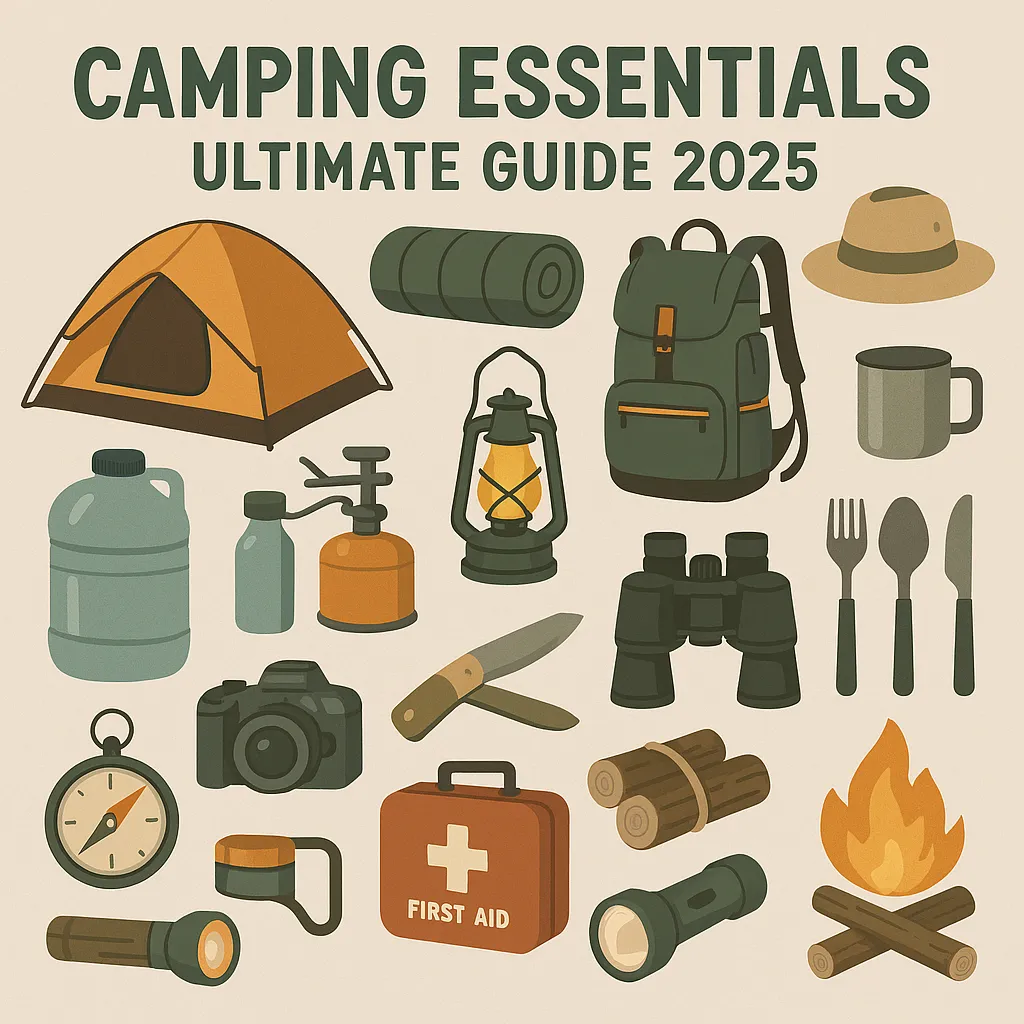
Recommended Articles:
- Lucky for Life Lottery (U.S.) Ultimate 2025 Guide
- Camping Essentials Ultimate Guide 2025(Keep up to date)
- How to Be Funny Ultimate 2025 Guide
- 100 Best Guess What Jokes Ultimate 2025 Guide
- What the Difference Between Jokes? 2025 In-Depth
- What Is a Homemaker? 2025 Expert-Backed Guide
- 100 Best Dad Jokes for Kids 2025 Ultimate Guide
- 100 Best Bad Dad Jokes 2025 Ultimate Guide
- 100 Best Deez Nuts Joke 2025 Ultimate Guide
- 100 Best Candice Joke 2025 In-Depth Guide
- Top 100 Best Christmas Movies 2025 In-Depth Guide
- Top 100 Best Christmas Family Games 2025
- Top 100 Best Fun Family Games 2025 In-Depth Guide
- Top 100 Best Family Games 2025 Ultimate Guide
- 100 Talk Show Hosts 2025 In-Depth Guide
- 100 Best Funny Dad Jokes 2025 In-Depth Guide
- 100 Best Funny Games 2025 In-Depth Guide
- 100 Best Funny Names 2025 In-Depth Guide
- 100 Best Good Jokes 2025 In-Depth Guide
- 100 Best Christmas Jokes 2025 🎅 In-Depth Guide
- 100 Best Corny Jokes 2025 In-Depth Guide
- 100 Best Kids Jokes 2025 In-Depth Guide
- 100 Best Knock Knock Jokes 2025 In-Depth Guide
- 100 Best Dark Jokes 2025 😈 | In-Depth & Hilarious Guide
- 100 Best Dark Humor Jokes 2025 In-Depth Guide
- 100 Attractions in the World 2025 In-Depth Guide
- Top 100 Attractions in the World 2025
- US Female Movie Stars Top 10 2025 In-Depth Guide
- Top 100 Party Entertainment Ideas 2025
- 100 Best Dad Jokes That Never Get Old 2025
- How to Make Slime 2025 In-Depth Guide
- YouTube History Top 10 Funny Videos 2025 In-Depth
- How to Make a Paper Airplane 2025 In-Depth Guide
- The Funniest Dad Jokes 2025 In-Depth Guide
- 100 Funny Jokes 2025 In-Depth Guide
- 2025 100 Best Dad Jokes In-Depth Guide
- Best Dry Humor 2025 In-Depth Guide
- Why Are Dogs So Cute? In-Depth Guide 2025
- Can Dogs Eat Cat Food 2025 In-Depth Guide
- What is the Krabby Patty Secret Formula? 2025 Deep Dive
✅ Amazon's Best Gift Ideas
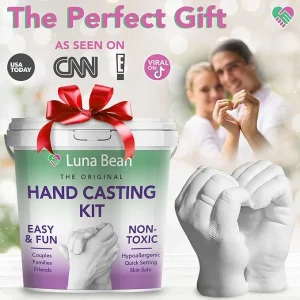
Luna Bean Hand Casting Kit – The Original Hand Mold Kit for Couples – Christmas Gifts, Bridal Shower, Wedding, Engagement Gifts for Her Him Anniversary for Men Women Wife Husband Boyfriend Girlfriend
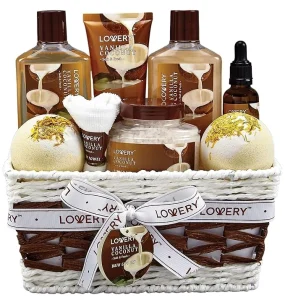
Gifts For Women Gift Basket for Women– 9 Piece Set of Vanilla Coconut Home Spa Set, Includes Fragrant Lotions, Extra Large Bath Bombs, Coconut Oil, Luxurious Bath Towel & More
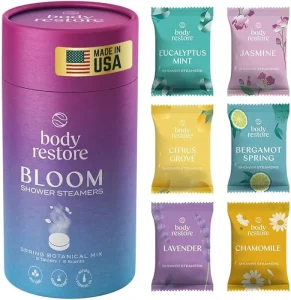
Body Restore Shower Steamers Aromatherapy 6 Pack - Christmas Stocking Stuffers, Birthday Gifts for Women, White Elephant, Relaxation, Self Care for Men - Bloom
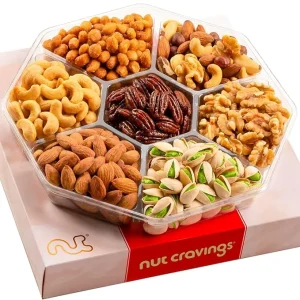
NUT CRAVINGS - Diwali Sweets Hamper Mid-Autumn Festival Mixed Nuts Gift Basket in Red Gold Box (7 Assortments, 1 LB) Food Arrangement, Healthy Snack Care Package, Food Assortments

From Crook to Cook: Platinum Recipes from Tha Boss Dogg's Kitchen (Snoop Dogg Cookbook, Celebrity Cookbook with Soul Food Recipes)

Bluetooth Speaker with HD Sound, Portable Wireless, IPX5 Waterproof, Up to 20H Playtime, TWS Pairing, BT5.3, for Home/Party/Outdoor/Beach, Stocking Stuffers, White Elephant Gifts for Adults (Black)
2026 Annual Event😊:
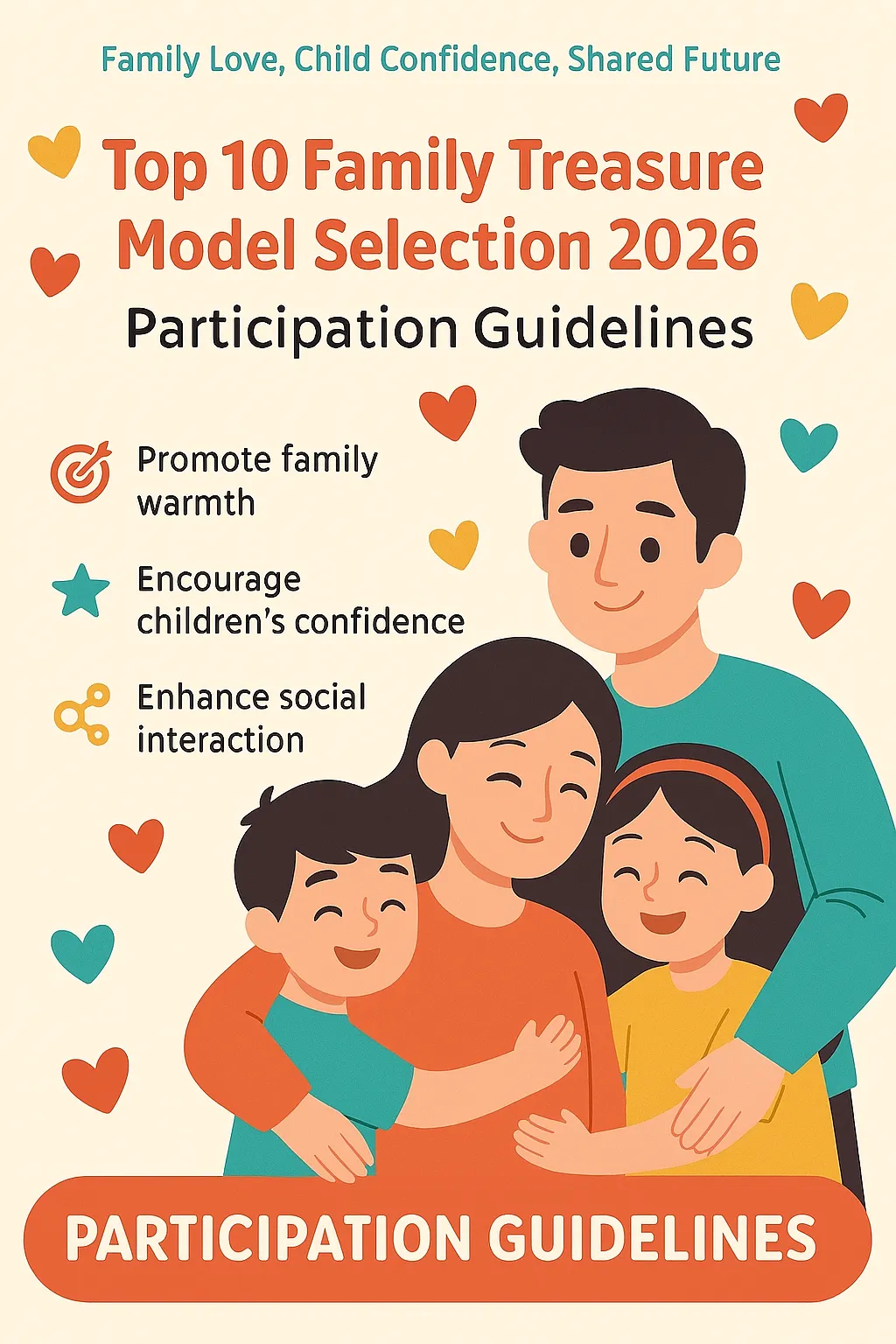
💕2026 Top Ten "Family Treasure" Model Selection💕
Participation Guidelines
🎯 Purpose of the Event
- Promote family warmth: Showcase the love and companionship between parents and children
- Encourage children’s confidence: Cultivate stage presence and creativity
- Enhance social interaction: Build a platform for family and community engagement
👶 Eligibility
- Age requirement: Children aged 3–12
📅 Event Schedule
- Registration period: December 1, 2025 – December 1, 2026
📝 Registration Method
- Online registration: Send application materials to Email: [email protected]
- Required materials:
- A child’s daily photo or a talent performance video (1–2 minutes)
- One family group photo
- A brief family story or participation statement
🏅 Awards
- Honorary Title: Top Ten "Family Treasure" Models
- Recognition: The names and corresponding photos of the winners
- Will be permanently displayed on the website loveahh.com
📌 Notes
- Authenticity of materials: All submitted information must be genuine and valid

